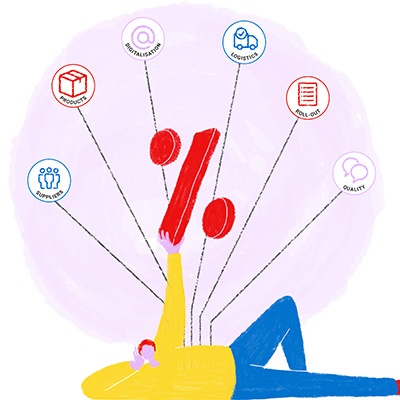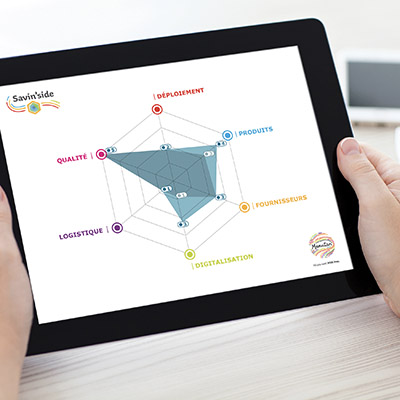The procurement function plays a vital role in a company's competitiveness and commercial value. This is hardly surprising, as procurement departments account for nearly 30% of turnover in service companies and at least 50% in industrial firms. Historically, buyers have always been tasked with reducing and optimising costs. In today's inflationary climate, this has become an absolute priority.
Cost optimisation: A key focus for procurement teams
Today, reducing, optimising, and controlling costs are the top priorities for procurement departments, according to the latest study conducted by PwC. This urgency is driven by the multicrisis environment businesses are currently navigating, starting with the Covid-19 pandemic, followed by the conflict between Ukraine and Russia, unrest in the Middle East, and various geopolitical tensions.
These challenges impact every sector. Corinne Loreaux, Director of Procurement at Société du Grand Paris, explains: "Procurement teams are reclaiming their central role within businesses to implement cost optimisation strategies during this period of high inflation".
In this context, procurement departments must develop effective cost reduction and optimisation strategies to maximise profitability without compromising overall performance. Philippe Dulou, Partner at EY Consulting for procurement and supply chain, notes: "A critical question in 2024 will be how to better manage costs amidst growing pressure on margins, as sales either stagnate or decline. Procurement departments must at least align cost reductions with sales trajectories to maintain an acceptable level of profitability."
It is therefore up to the procurement function to activate both quick and sustainable levers to reduce expenses without compromising quality. To achieve this, buyers can focus on reducing direct costs, such as the purchase price of goods and/or services, while also optimising indirect costs associated with the company's operations.
What are the key procurement levers for cost optimisation?
While there are numerous cost optimisation levers available, it is up to each procurement department to activate those best suited to their company's specific situation. This presents an opportunity to map out the company's expenditures and identify potential areas for cost savings.
Contractual negotiation
This is often the first cost optimisation lever activated by procurement departments. For a contractual negotiation to be effective, buyers must be well-prepared. They need to clearly define their objectives and the arguments to support their demands. To negotiate prices and contractual terms, they can, for example, commit to larger volumes of goods, secure favourable payment terms, or leverage competition. According to a Czech study, each new competitor introduced during a sourcing process contributes to an average 3.4% reduction in procurement costs.
Needs assessment
The procurement function can also take a proactive approach to optimise costs. This involves working closely with operational teams to review functional needs, adjust technical specifications, and develop the specifications document. The goal is to precisely meet the needs of internal clients while minimising the phenomenon of over-quality. Notably, companies tend to favour premium quality in over a third of long tail spend. However, this level of quality is not always the most relevant given the intended use of the product.
Total Cost of Ownership (TCO) perspective
Procurement departments must also leverage their expertise by adopting a Total Cost of Ownership (TCO) perspective. It is essential to look beyond the unit price and consider all associated costs, including:
- Transport expenses;
- Resources required for product use;
- The cost of spare parts and maintenance costs;
- Product lifespan.
All these factors must be taken into account to make informed long-term decisions. This strategic tool helps optimise both direct and indirect costs, thereby creating value.
Supplier rationalisation
This lever is particularly effective for long tail spend, which account for the majority of the supplier base. Most of these suppliers are low-activity, with a minimal annual order volume. Replacing them with a reference distributor offering a broad-enough range of products to meet various needs paves the way for indirect savings. This approach reduces supplier management costs, which average €1,000[1] per supplier annually, and, by extension, transactional costs as well.
Digitalisation of procurement processes
Cost optimisation also involves digitising procurement processes. With digital solutions, procurement departments can digitalise and automate a significant portion of their operations, from sourcing to invoice payments. This enhances efficiency and generates indirect savings.
E-procurement tools are a striking example of this: While the cost of a traditional transaction is estimated at €95[2], a fully digitalised transaction costs just €19[3]. This equates to 80% savings per transaction. Similarly, e-sourcing tools, combined with artificial intelligence technologies, can achieve an average of up to 10% cost reductions in procurement.
Ultimately, any cost reduction and optimisation strategy must be managed over the long term. By using key performance indicators (KPI), the procurement team can monitor achieved savings and adjust the action plan based on results. Moreover, this is an ongoing process that must adapt to market developments and the company's strategic priorities.
In summary, this approach not only reduces expenses but also improves efficiency and agility in increasingly demanding markets. However, this should not come at the expense of quality, safety, or supplier relationships. Strong cost management enables any business to contribute to sustainable and profitable growth.








